I’ve met quite a few people who live in fear of winter travel, or even winter staying-at-home. They’re utterly terrified of single-digit temperatures, and lock themselves up at the first sign of cloud. I’d brag, but I do the same thing when it’s too hot outside.
But I always try to point out that winter adventures need not be horridly atrocious nightmares. With a few carefully-chosen items, winter travel gear can be comfortable, functional, lightweight, relatively inexpensive, and still keep you warm and toasty the whole time. And the cornerstone of this intricate jigsaw puzzle is a packable down jacket.
What can a packable down jacket do for me?
Long known for making gloriously cozy comforters, goose down has a number of advantages over other materials that make it ideal for lightweight backpacking, even outside of winter. It’s the best way to go from “I was trudging through the frozen waste” to “I was exploring a beautiful winter wonderland.”
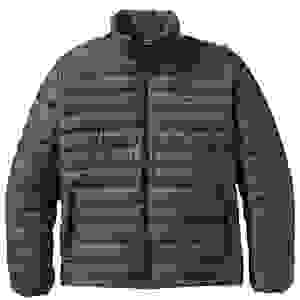
Observe:
- Warmth: Down is incredibly lofty, with millions of tiny bristles that keep warmth trapped inside. There’s very little on the planet as warm as high-quality goose down, particularly when it comes to materials that could actually make suitable clothing.
- Weight: The amount of down it takes to keep you warm weighs practically nothing, meaning you can make a down jacket that’ll be half the weight of comparably warm jacket made of other materials.
- Packability: All the loftiness that makes down warm and cozy also makes it incredibly compressible, meaning you can pack it into half the space of a typical fleece jacket.
And those are just the advantages of down itself; but since it’s almost always built into a jacket made of lightweight nylon, you get these added bonuses as well:
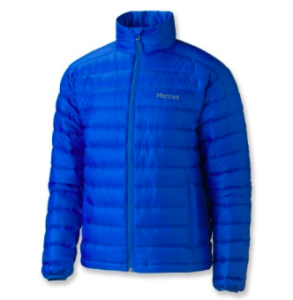
- Weather resistance: Pretty much all down jackets are windproof and water resistant, making them excellent outer layers, whereas even a thick fleece would probably still need an additional layer to keep out the wind.
- Silky smooth: They’re usually so frictionless that you can stuff a down jacket into nooks and crannies that would otherwise be empty, meaning it can often disappear into empty air pockets as if by magic. It also makes a nice, soft cushion for fragile belongings.
Where does a lightweight down jacket really excel?
Because of this particular combination of advantages, I find down jackets to be absolutely essential for ultralight winter travel, but they’re also quite useful in chilly fall or spring adventures. Instead of getting a super-warm parka, you can get a mid-weight jacket that’ll be useful in milder weather, and simply add other pieces when it gets down to freezing.

They’re also incredibly useful for the dreaded multi-season trip (or multi-elevation trip), which requires summer and winter gear to be packed into the same bag, with winter gear sitting uselessly half the time.
Since down jackets are lighter and more compressible than just about anything else, they’re by far the best option for these sorts of adventures. An unused down jacket will be half the size and weight of an unused anything-else jacket, making it a lot less annoying to haul around when not in use, allowing you to build a RTW packing list without much trouble.
My favorite setup is to use a lightweight fleece or wool zip-up sweater, which makes an excellent next-to-skin layer to wear over a t-shirt, and then add a packable down jacket on top, which makes an excellent weather-resistant outer layer. This allows for the versatility of multiple layers, while still remaining physically comfortable, fairly weather resistant, and light.
And now for details:
What the heck is fill power?
This is essentially the quality rating of the down. Fill power is the measurement of how much volume it fills up for a certain weight, after it’s compressed and allowed to expand once again. The higher the number, the better it is.

But since it’s a measure of both volume and weight, higher fill power doesn’t necessarily mean it’s warmer. It means it’ll be warmer for the same weight, or it’ll be lighter for the same warmth. More packable, too.
So yes, higher is better, but keep in mind it doesn’t necessarily mean a jacket with a higher fill power will be warmer. You could easily have a 600 fill power jacket just as warm as an 800 fill power jacket; it’s just that the 800 fill power jacket would probably be lighter and more packable, though it would also depend on thickness of fabric, how many zippers it has, overall length, and so on. A lower fill power will also be significantly cheaper, though you’ll be compromising somewhat on weight and compressibility.
What’s a good fill power?
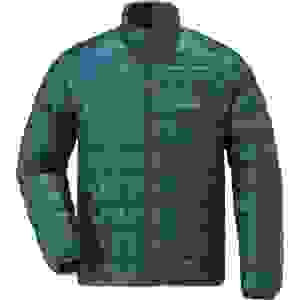
Most down jackets are somewhere around 400 to 600, but premium brands, such as those you’d find in a camping store, are typically around 800. They’ll cost more, but you’ll maximize the benefits of warmth, weight, and compressibility, and it’s not a bad investment if you live somewhere cold.
I’ve seen fill power go up to 1000, but it’s extremely rare, and quite expensive, as it requires selecting the highest quality feathers by hand. If you need the absolute best, well then okay. But keep in mind it’s only going to be 25% warmer (or 25% lighter) than 800 fill power down, but it could be twice as expensive.
For most purposes, 800 will be super warm, exceptionally light, and easily packable. And it’ll say it’s 800 right on the label. If you can’t find the fill power, you can be pretty sure it’s significantly lower, since they don’t want to bring attention to it. But again, a lower rating might not be so bad, particularly if you don’t plan on using it so often, or if you have plenty of space in the pack, and so on.
How much should I spend?
A high-quality down jacket can be anywhere from $100 to $1000. But typically they’ll be in the $150 to $250 range. Lower fill powers can bring the price down to $50, but it won’t be as ultralight or packable as you might want.

Since the raw material can be expensive, particularly for higher-quality down, there will often be a direct correlation between warmth and cost, meaning a lightweight down jacket might be $150, whereas a serious winter parka might be more like $300 or more. With exceptions, of course.
Personally, I prefer to keep each individual piece pretty light, and add extra layers during winter. A super-warm winter parka will only be useful in the winter, whereas a lighter jacket might be useful year-round when combined with other layers, so you won’t have to spend so much anyway. This will of course depend on where you live and travel, and how cold you usually get.
What’s the downside?
As magical as it might sound, goose down has one glaring deficiency: It’s terrible in the rain. Once it’s damp, it’ll stop being warm, and it’ll take a while to dry out once again.
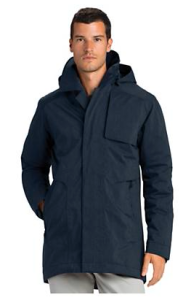
Luckily for you, this is a fairly easy problem to solve. All you need is an umbrella or a rain jacket, and you’ll be fine. You might be doing this anyway, but it’s especially important if you’re somewhere cold, and goose down is your body-heating weapon of choice.
It’s possible to find waterproof down jackets, and chemically treated goose down that’ll perform significantly better in the rain, but these can be fairly expensive, whereas you might have a rain jacket already anyway, so you might as well use it. They’re not a bad idea, though.
Keep in mind that if it’s below freezing the whole time, you don’t need to worry too much about rain.
On the other hand, you can go synthetic:
What about a synthetic packable jacket?
Though nothing on the planet seems to be as good as goose down for insulation and compressibility, synthetic insulation has one major advantage: It’ll work in the rain. While down wilts when it’s damp, synthetic insulation will retain some insulation value, and it’ll dry quickly. This can be incredibly helpful if you find yourself caught in a rainstorm without real rain protection.
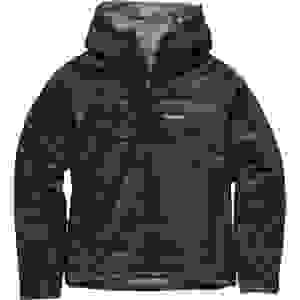
So although a synthetic packable jacket won’t offer the weight or compressibility advantages of goose down, it’ll get fairly close (still better than fleece), and that might be all you need. And as an added bonus, it’s almost always cheaper than down. Plus it’s vegan!
I wouldn’t say there’s a “correct” answer between down and synthetic, as it just depends on how you plan to use it, and how much you can spend.
Personally, I’ve used a synthetic, hooded, insulated jacket for years, and if it rains a little, I’ll probably be fine. For city travel, where you can duck under cover occasionally, it works.
But if you’re planning on walking around for hours at a time and you don’t want rain holding you back, you’ll definitely need a real rain jacket or an umbrella, regardless of whether you’re using down or synthetic. But you’ll definitely want real rain protection if all you’ve got is goose down.
Do I need a hood?
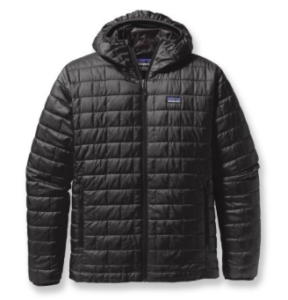
This is a bit of a tangent from the previous segment, and, again, just depends on how you want to handle things. If you’ve got a synthetic jacket and don’t mind walking around in the rain for a few minutes at a time, hoods are great. If you’re using goose down, you’ll probably want an umbrella or a rain jacket, in which case the hood might be kinda useless.
It’ll come down to personal preference, but hoods make a lot more sense for synthetic jackets, since they’ll be able to handle a little rain without much trouble. If you’re using down, you’ll probably want to rely on a real rain jacket, which will have its own hood anyway, unless you’re using a waterproof down jacket.
How about a vest?
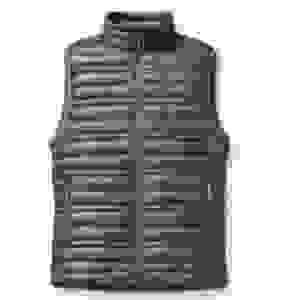
Vests are a good alternative to a big puffy jacket, since they’ll keep your torso nice and warm, without getting too bulky in the sleeves. This is especially helpful if you’re combining several layers together, which eventually makes it impossible to bend your elbows.
I would say that if you’re getting a vest, it makes more sense to use goose down, rather than synthetic. Since it’s only a partial layer, you’ll probably have something like a rain jacket as well, in which case you won’t need to worry about the down getting wet. The only advantage to a synthetic vest in this case would be that it’s usually cheaper.
Is there a best packable down jacket?
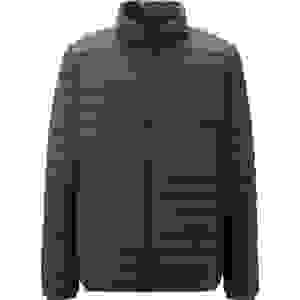
Nah, there’s no such thing as the best down jacket, as it often comes down to personal preference regarding fit, features, fabric, and so on. They’re all using the same raw material anyway. Remember that it’ll probably have to fit together with other pieces, so it’ll have to be looser than a fleece jacket or sweater, but slimmer than a rain jacket, and suitable for your body type.
That said, all the jackets and vests featured on this page are highly regarded items from reputable brands, many of which back their products with thoroughly impressive warranties. I also tried to pick the ones that have been around for years, rather than this-year-only models that’ll disappear sooner or later. There are certainly plenty of other great items out there, but the items listed above will be rock solid, and follow you on plenty of adorable adventures all over the world.
I am, however, happy to point people to Patagonia and North Face, who are working to eliminate problems with animal abuse in the supply chain. If you’re at all worried about the treatment of the animals involved, those are great places to look.
A little note on repairs: It’s easy to patch torn fabric with super-strong tape, and there’s a really neat set of repair tape from McNett, known as Tenacious Tape Tattoos. Not only do they create a permanent repair job, but they’re also cut into fun shapes, like dinosaurs, stars, moons, and other neat doodads. Instead of your jacket looking like it’s torn apart and taped over, it just looks like you’ve added some flair. McNett sent me a couple free sets, and I’m no longer dreading the moment my down jackets get torn apart, but looking forward to adding some fun nature scenes to them.
Have fun!

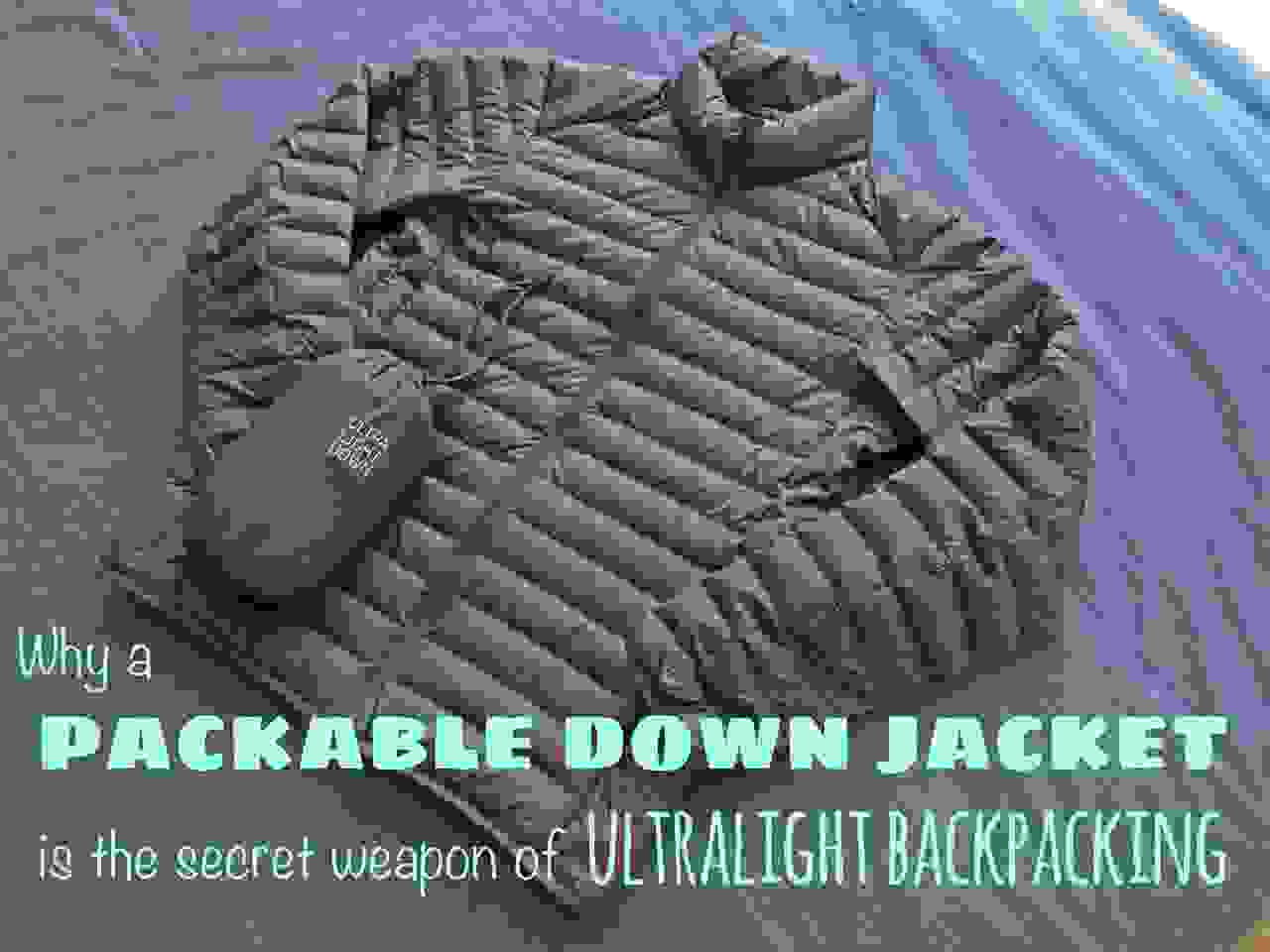



Nice article.
May want to add that the synthetics aren’t that warm in cooler weather unless one is active (as in moving i.e. hiking, running, etc…). I don’t believe people who use synthetics and say that they wear just a t-shirt underneath the synthetic jacket and it’s warm when it’s in the 40s [to low 50s] esp. in the New England area where that type of temp. is somewhat cold.
I own the Patagonia Nano hoody and nearly froze in the low 50s with a t-shirt and lightweight fleece underneath. The only thing that kept me warm was walking briskly.
I also have the Sierra Design lightweight Gnar Down hoody and it’s good down to ~40 F but still have to layer underneath with a long sleeve shirt and mid-weight fleece. New England has not only cold temps but cold, chilly winds esp. at night.
Best to keep an eye on sales on those lightweight down jackets/hoodies as some can get nearly 50% off which is a good deal. Don’t forget to sign up at certain websites like eBates.com or MrRebates.com to see if certain websites qualify for additional discounts via rebates.
Yeah, moving around will definitely heat you up. I do hear that down can help regulate temperature a little bit, by losing some of its loft at higher temperatures, but most temperature-regulating things only go so far, and I tend to get really overheated anyway and can barely tell. But apparently some other people out there say that down can do this.
Great blog! Is there a waterproofing product/spray for the packable down coat I just bought at Costco?
Yeah, you can get things like Nikwax, or similar products from Gear Aid and so on. I don’t really know if one works better than another, since it takes a while to tell, and you’d also need two identical jackets to compare side by side, so it’s a little tricky.
Is it necessary to get a size bigger?
Usually not. Most down jackets are sized to fit over another layer, although it depends what that layer is. If it’s a loose-fitting fleece jacket, then you might need to size up. But if it’s a snugly-fitting jacket, then the down jacket is probably fine in its regular size. A lot of brands design them in relation to each other, too, so a size medium fleece jacket from a certain brand often goes perfectly with a size medium down jacket from the same.
How wear-resistant are lightweight puffies to the normal friction of a backpack? Once upon a time the wisdom was to always cover a down jacket with a shell…but that was decades ago.
That shouldn’t be a problem at all. Down jackets are so slippery that there won’t be any damage from the friction of a backpack strap. From rocks, yes. Also thorns, cat claws, and so on, but there needs to be some sharpness or rough texture to do any damage.
Looking to get either Montane Featherlight or Black Ice – completely different i know but which would be more suited to walking around in ski resorts approx -5 to 5 degree celsius. Don’t want a jacket that is too warm or cold!
Typo in your Mountain Hardwear 8000 Meter Insulated Suit caption: “They know longer make this” should be “They no longer make this”.
My Eddie Bauer First Ascent down sweater gave me long, long service, and now I’m trying out the North Face Thermoball synthetic jacket.
Dang it, you’re right. Fixed.
Hoods stop a lot of heat loss but rustle in your ears when you move at all. I use a pack away Kathmandu brand down jacket I have used for well over a decade and tested it exploring a city in Siberia at -15 Celsius with only a long sleeve t-shirt under it and it was fine.
We live in Florida and can tolerate 90 degrees easier than 60 degrees. We are going to Germany in October where it will likely be lower 40’s to lower 50’s. We are looking for packable warm jackets but don’t need anything for freezing temperatures. We also won’t use them much after this trip. I am having difficulty distinguishing between jackets for really cold weather and those that are for mildly cold (to us). Your column was very helpful but I am still confused as to which types of jackets would fit our needs. Florida is not the best place to be able to shop, see these jackets in person and get recommendations.
I appreciate any help you can give us!
Sorry for the late response on this one; the issue is mostly going to be weight. Obviously 600 fill power vs. 800 fill power will make a difference, but only by 33%, whereas a 10 ounce jacket vs a 20 ounce jacket would be a 100% difference. You’ll probably want something in the 10-12 ounce range. That’ll be plenty if worn over a light sweater or even just a long sleeve shirt, aided by a hat and scarf if necessary. Ears get cold even if you’re otherwise wrapped up in cozy jackets.
Do you have an opinion on the shell material – nylon or polyester?
I think there’s so much variation in each of those materials that I wouldn’t worry about it. They both seem to work just fine. I hear nylon is a little stronger, and polyester dries a little faster, but the differences aren’t really all that crazy.
WHERE CAN I GET A REPLACEMENT CARRY BAG FOR MY UNIGLOW ULTRALIGHT PARKA??
You might have to buy a whole new one…although plenty of companies sell little drawstring bags. Sea to Summit has some really lightweight options.
You can also just turn a pocket inside out on the jacket and stuff it in there.